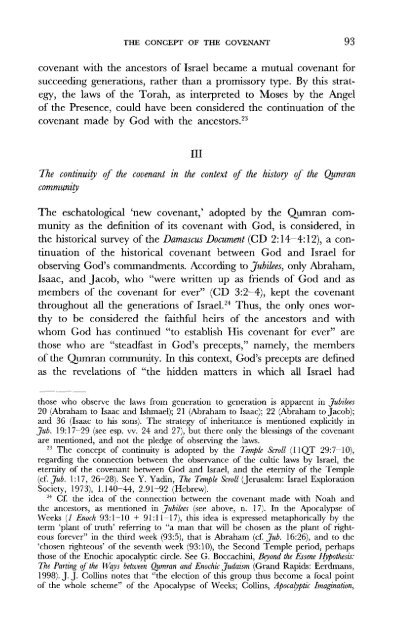historical perspectives: from the hasmoneans to bar kokhba in light ...
historical perspectives: from the hasmoneans to bar kokhba in light ...
historical perspectives: from the hasmoneans to bar kokhba in light ...
Create successful ePaper yourself
Turn your PDF publications into a flip-book with our unique Google optimized e-Paper software.
THE CONCEPT OF THE COVENANT 93<br />
covenant with <strong>the</strong> ances<strong>to</strong>rs of Israel became a mutual covenant for<br />
succeed<strong>in</strong>g generations, ra<strong>the</strong>r than a promissory type. By this strategy,<br />
<strong>the</strong> laws of <strong>the</strong> Torah, as <strong>in</strong>terpreted <strong>to</strong> Moses by <strong>the</strong> Angel<br />
of <strong>the</strong> Presence, could have been considered <strong>the</strong> cont<strong>in</strong>uation of <strong>the</strong><br />
covenant made by God with <strong>the</strong> ances<strong>to</strong>rs. 23<br />
Ill<br />
The cont<strong>in</strong>uity of <strong>the</strong> covenant <strong>in</strong> <strong>the</strong> context of <strong>the</strong> his<strong>to</strong>ry of <strong>the</strong> Qumran<br />
community<br />
The escha<strong>to</strong>logical 'new covenant,' adopted by <strong>the</strong> Qumran community<br />
as <strong>the</strong> def<strong>in</strong>ition of its covenant with God, is considered, <strong>in</strong><br />
<strong>the</strong> <strong>his<strong>to</strong>rical</strong> survey of <strong>the</strong> Damascus Document (CD 2:14-4:12), a cont<strong>in</strong>uation<br />
of <strong>the</strong> <strong>his<strong>to</strong>rical</strong> covenant between God and Israel for<br />
observ<strong>in</strong>g God's commandments. Accord<strong>in</strong>g <strong>to</strong> Jubilees, only Abraham,<br />
Isaac, and Jacob, who "were written up as friends of God and as<br />
members of <strong>the</strong> covenant for ever" (CD 3:2-4), kept <strong>the</strong> covenant<br />
throughout all <strong>the</strong> generations of Israel. 24 Thus, <strong>the</strong> only ones worthy<br />
<strong>to</strong> be considered <strong>the</strong> faithful heirs of <strong>the</strong> ances<strong>to</strong>rs and with<br />
whom God has cont<strong>in</strong>ued "<strong>to</strong> establish His covenant for ever" are<br />
those who are "steadfast <strong>in</strong> God's precepts," namely, <strong>the</strong> members<br />
of <strong>the</strong> Qumran community. In this context, God's precepts are def<strong>in</strong>ed<br />
as <strong>the</strong> revelations of "<strong>the</strong> hidden matters <strong>in</strong> which all Israel had<br />
those who observe <strong>the</strong> laws <strong>from</strong> generation <strong>to</strong> generation is apparent <strong>in</strong> Jubilees<br />
20 (Abraham <strong>to</strong> Isaac and Ishmael); 21 (Abraham <strong>to</strong> Isaac); 22 (Abraham <strong>to</strong> Jacob);<br />
and 36 (Isaac <strong>to</strong> his sons). The strategy of <strong>in</strong>heritance is mentioned explicitly <strong>in</strong><br />
Jub. 19:17-29 (see esp. vv. 24 and 27), but <strong>the</strong>re only <strong>the</strong> bless<strong>in</strong>gs of <strong>the</strong> covenant<br />
are mentioned, and not <strong>the</strong> pledge of observ<strong>in</strong>g <strong>the</strong> laws.<br />
23 The concept of cont<strong>in</strong>uity is adopted by <strong>the</strong> Temple Scroll (11QT 29:7—10),<br />
regard<strong>in</strong>g <strong>the</strong> connection between <strong>the</strong> observance of <strong>the</strong> cultic laws by Israel, <strong>the</strong><br />
eternity of <strong>the</strong> covenant between God and Israel, and <strong>the</strong> eternity of <strong>the</strong> Temple<br />
(cf. Jub. 1:17, 26-28). See Y. Yad<strong>in</strong>, The Temple Scroll (Jerusalem: Israel Exploration<br />
Society, 1973), 1.140-44, 2.91-92 (Hebrew).<br />
24 Cf. <strong>the</strong> idea of <strong>the</strong> connection between <strong>the</strong> covenant made with Noah and<br />
<strong>the</strong> ances<strong>to</strong>rs, as mentioned <strong>in</strong> Jubilees (see above, n. 17). In <strong>the</strong> Apocalypse of<br />
Weeks (1 Enoch 93:1-10 + 91:11—17), this idea is expressed metaphorically by <strong>the</strong><br />
term 'plant of truth' referr<strong>in</strong>g <strong>to</strong> "a man that will be chosen as <strong>the</strong> plant of righteous<br />
forever" <strong>in</strong> <strong>the</strong> third week (93:5), that is Abraham (cf. Jub. 16:26), and <strong>to</strong> <strong>the</strong><br />
'chosen righteous' of <strong>the</strong> seventh week (93:10), <strong>the</strong> Second Temple period, perhaps<br />
those of <strong>the</strong> Enochic apocalyptic circle. See G. Boccach<strong>in</strong>i, Beyond <strong>the</strong> Essene Hypo<strong>the</strong>sis:<br />
The Part<strong>in</strong>g of <strong>the</strong> Ways between Qumran and Enochic Judaism (Grand Rapids: Eerdmans,<br />
1998). J. J. Coll<strong>in</strong>s notes that "<strong>the</strong> election of this group thus become a focal po<strong>in</strong>t<br />
of <strong>the</strong> whole scheme" of <strong>the</strong> Apocalypse of Weeks; Coll<strong>in</strong>s, Apocalyptic Imag<strong>in</strong>ation,

















